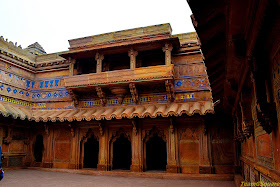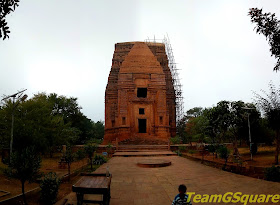A chilly Gwalior welcomed us after a hectic drive
from
Shivpuri. The temperature here was
below 10 degree centigrade, typical of the Northern Indian climate in January.
We checked into Hotel Ambassador and decided to rest for the day due to the
weather and the temperature only kept going down, creating uneasiness to our little
one. As he started to catch cold, he became more uncomfortable and woke up from
his sleep crying loud. We tried to comfort him and gave him the required
medicines. As the hotels there did not have a heater installed in rooms, we had
no other choice but to request for a separate heater and only wished their
response was positive. Fortunately, he obliged to the request and did the
needful, which helped us much that night. Our little one felt much better after
getting the room heater and slept peacefully for rest of the night. We woke up
late the next morning only to realize it was totally foggy outside and decided to
stay indoors until the situation improved. We stepped out at around 10.30 am to
check out the town of Gwalior, though it remained foggy with a slight drizzle too.
 |
| This is How Gwalior Fort Looked at Noon |
Gwalior always has been in our list of places to
visit for various reasons, right from its role in India's first war of
Independence to the Nanda dynasty rule of Pataliputra during early 6th century
BC. The state of Gwalior rose to prominence with Chieftain Suraj Sen. He met
saint Gwalipa who lived on the hilltop where the fort now stands and was cured
of his disease by the saint. In return, Suraj Sen founded the city and named it
after the saint. Thus Gwalior was founded. Man Singh Tomar, the great ruler of
Tomar dynasty improved the fort here and built the most famous palace of
Gwalior, the Man Mandir Palace. Later this fort was captured by the Mughals and
remained under them for a long period, after which in 1810, it came under the
control of the Scindia dynasty and finally the Sepoy Mutiny of 1857, led by Tantya
Tope and
strongly supported by Rani
Lakshmi Bai. Both the brave warriors gave up their lives during the struggle
for independence of this great country.
The Scindia Chhatris: The lesser known
Chhatri complex of Scindia rulers stands mute in the busy lanes of Gwalior. This
was the first place we visited in Gwalior and reaching this place was easy. We
were greeted by two huge and magnificent cenotaphs. The larger Chhatri was
built in 1817 to commemorate Maharaja Jiyaji Rao Scindia and the smaller
Chhatri was built in 1843 in memory of Maharaja Janakaji Scindia.
 |
| Maharaja Jiyaji Rao Scindia Chhatri |
Gwalior Fort: This most impressive
structure of Madhya Pradesh is built on a small hillock. Other monuments inside
the fort are the Man Mandir Palace, Hathi Pol, Karn Mahal, Vikram Mahal, Gujari Mahal, Shah Jahan Mahal, Jahangeer Mahal and many such.
 |
| Qila Gate/ Gwalior Gate |
 |
| Blue Tiled Walls of Gwalior Fort |
 |
| Inside Man Mandir Palace |
Saas-Bahu Temple (Mother-in-law
Daughter-in-law Temple): Built
in the 11-12th century by Mahipala Kachhwaha, this temple is dedicated to Lord
Vishnu.
 |
| Saas - Bahu Temple Complex |
Chaturbhuj Temple: Here is the world's
first written zero found! The inscribed slab is believed to be of a much
earlier period than the temple which was built by Pratiharas in 9th century.
 |
| Chaturbhuj Temple |
 |
| World's First Written Zero |
Teli Ka Mandir: This 9th century temple
built by Pratiharas is the tallest temple, with its unusual shikhara.
 |
| Teli Ka Mandir |
Jain Rock Cut Temples: These were
built over 800 years, from the 7th century and are dedicated to various Jain Tirthankaras.
The tallest murti (idol) here is that of the first Jain Tirthankara, Adinath.
 |
| Lord Adinath |
Moti Mahal: This 19th century palace built
by the Scindia kings was the Secretariat of Madhya Bharat government back then.
There is a beautiful garden with a neatly done network of fountains in front of
this palace.
 |
| Moti Mahal |
Tomb of Mohammad Ghaus: This huge building
crowned with a large dome is dedicated to the 16th century Muslim saint
Mohammad Ghaus.
 |
| Tomb of Mohammad Ghaus |
Tomb of Tansen: It is a small tomb
dedicated to the greatest classical singer Tansen, who was the leading singer
in Akbar’s court. He was also one among the navaratnas (nine gems). The tomb is
in the same complex as that of the Tomb of Mohammad Ghaus and is much smaller in
size. The tomb is located besides a tamarind tree, whose leaves were chewed by
Miyan Tansen for a sweet voice.
 |
| Tomb of Tansen and Famed Tamarind Tree |
Light and Sound Show: Every evening the MPSTDC runs an hour’s
light and sound show at the Man Mandir Palace inside the fort in the two
languages of Hindi and English.
 |
| Lit Gwalior Fort |
Others Places to Visit: Jai Vilas Palace
Museum, Nag Dev Mandir, various parks, and many more.
Entry Fee: The Entry fee collected for various
sites are as below,
A. Man Mandir Palace - Rs 15/- for Indians and Rs
200/- for Foreigners
B. Royal enclosure - Rs 15/- for Indians and Rs
200/- for Foreigners
C. Gujari Mahal/ ASI Museum - Rs 5/- for all,
Monday Holiday
D. Light and Sound Show - Rs 100/- for all
E. Jai Vilas Palace Museum - Rs 60/- for Indians
and Rs 350/- for Foreigners
Accommodation:- We stayed for a day
at Hotel Ambassador which offered very basic amenities and held a decent and
friendly staff, though not very clean. Our second day accommodation was at
Hotel Shelter, a bit upscale hotel with nice ambiance, centrally located, mid-range
and friendly staff. Being a popular tourist destination, there are many options
tailored to meet the varying budgets. Hotel Tansen Residency is another good
one being maintained by MPSTDC.
Where to eat: Options are many. There should be no difficulty in finding a
suitable place for meals.
References:
1. RBS visitors Guide India Madhya Pradesh
2. DK Eyewitness Travel India
Related Posts:
PS: A new page has been added to our blog, which has a collection of our
Vlogs.
Click here to view.


















Wow... Beautiful...
ReplyDeleteGwalior has always been in my wishlist. Glad to see your post.
ReplyDeleteVery useful information. Nice photos.
ReplyDeleteWow, all of the sturctures look stunning. Really intrigued with the Saas Bahu temple, it sounds very unique.
ReplyDeleteYou are so lucky, to live in the best country in the world. Beautiful architectural.
ReplyDeleteThanks for this tour!
ReplyDeleteWonderful Photos of the stunning structures..
ReplyDeletebeautiful :)
ReplyDeleteWonderful exploration of Gwalior.
ReplyDeleteHaving stayed in Gwalior for a good 5 years I feel more connected with your post. Beautiful captures and very informative text. Keep posting more.
ReplyDeleteGawalior is in my places to visit list, hopefully after monsoon season. Loved the blue tiled picture. Marked your post for reference.
ReplyDeleteGwalior fort is amazing . Great pics. Thanks for sharing
ReplyDelete